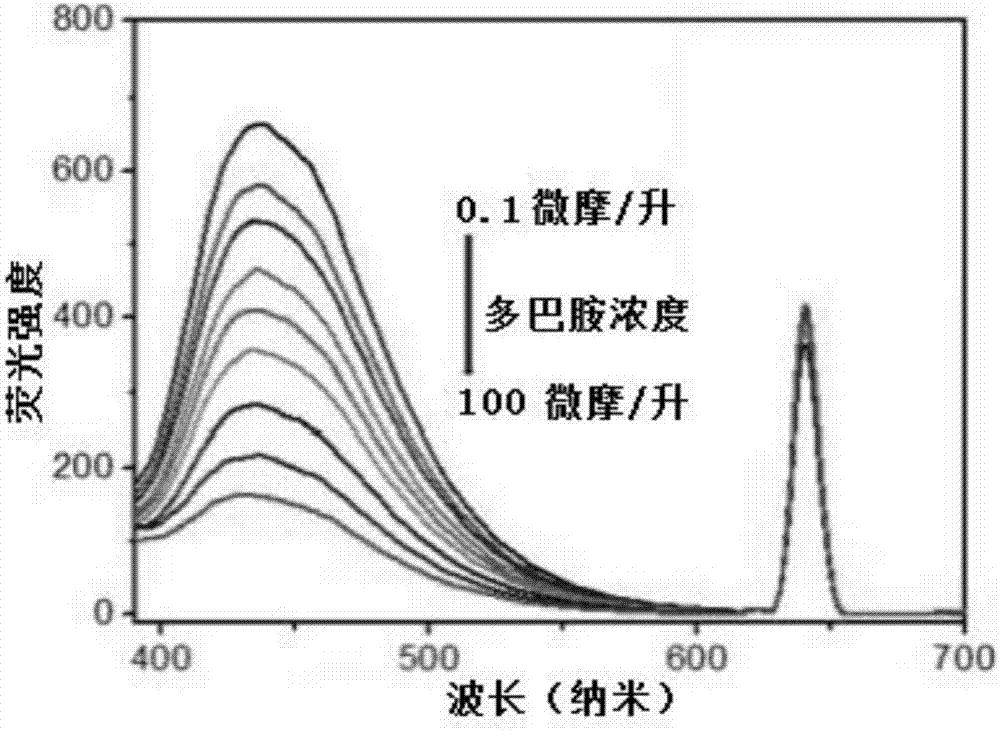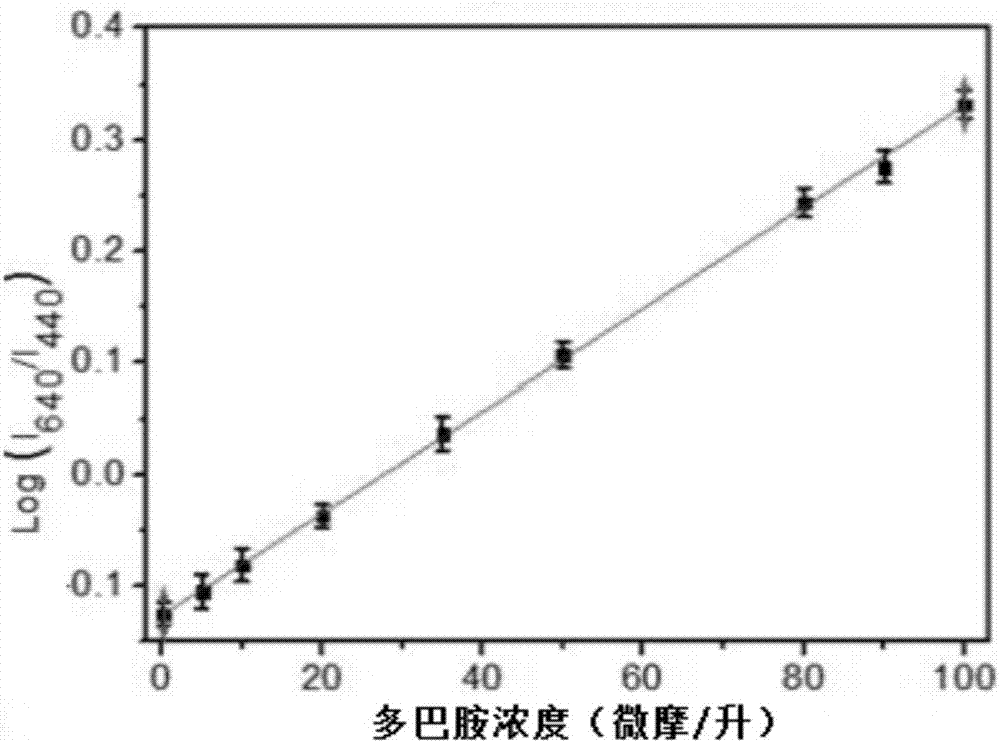Method for preparing ratio fluorescence dopamine probe based on carbon spot/copper nanocluster compound
A technology of copper nanoclusters and ratiometric fluorescence, which is applied in the intersecting fields of nanomaterials and fluorescence sensing, can solve problems such as carbon dots/copper nanocluster composites that have not yet been retrieved, and achieve high selectivity, low preparation cost, and excellent preparation process. simple effect
- Summary
- Abstract
- Description
- Claims
- Application Information
AI Technical Summary
Problems solved by technology
Method used
Image
Examples
Embodiment 1
[0023] Dissolve 0.1 g of sodium citrate and 0.75 g of ammonium bicarbonate in 10 ml of double distilled water, stir well to form a homogeneous mixed aqueous solution, transfer it to an autoclave, react at 180°C for 4 hours, and then cool to room temperature , using a dialysis bag with a molecular weight of 1000 Daltons for dialysis treatment for 24 hours, using a rotary evaporator to remove water from the solution in the dialysis bag to obtain a suspension, using acetone to precipitate the product, centrifuging, washing with ethanol to obtain a precipitate, and then drying to remove water to obtain Carbon dots. Weigh 20 mg of 1-(3-dimethylaminopropyl)-3-ethylcarbodiimide sodium hydrochloride (EDC), 10 mg of N-hydroxysuccinimide sodium (NHS) and 20 mg of aminophenylboronic acid Dissolve in 20 ml of double distilled water, mix well to form a homogeneous aqueous solution, stir thoroughly for 1 hour, add 1 mg / ml of carbon dot water dispersion, continue to stir and react at room te...
Embodiment 2
[0025]For the preparation of blue fluorescent emitting carbon dots, the surface of the carbon dots is modified with aminophenylboronic acid, and the preparation of red fluorescent emitting bovine serum albumin-stabilized copper nanoclusters is shown in Example 1. First, 2.0 mg / ml surface aminoboronic acid modified carbon is prepared The water dispersion liquid of point, under magnetic stirring, add 20 milligrams bovine serum albumin stabilized copper nano-clusters therein, and 30 milligrams EDC and 18 milligrams NHS, then add 100 milliliters pH=7.4 substance concentration is 1 millimolar / 1 liter of phosphate saline buffer solution to form a homogeneous mixed system, and stirred at room temperature for 10 hours. The reaction product is precipitated with acetone, the precipitate is centrifuged, washed repeatedly with ethanol, and dried to obtain the carbon dot / copper nano cluster composite. A 2.0 mg / ml water dispersion of the carbon dot / copper nanocluster composite was prepared...
Embodiment 3
[0027] For the preparation of blue fluorescent emitting carbon dots, the surface of the carbon dots is modified with aminophenylboronic acid, and the preparation of red fluorescent emitting bovine serum albumin-stabilized copper nanoclusters is shown in Example 1. First, 3.0 mg / ml surface aminoboronic acid modified carbon is prepared The water dispersion liquid of spot, under magnetic stirring, add 30 milligrams of bovine serum albumin stabilized copper nano-clusters therein, and 45 milligrams of EDC and 27 milligrams of NHS, then add 150 milliliters of pH=7.4 substance concentration is 1 millimolar / 1 liter of phosphate saline buffer to form a homogeneous mixed system, and stirred at room temperature for 12 hours. The reaction product is precipitated with acetone, the precipitate is centrifuged, washed repeatedly with ethanol, and dried to obtain the carbon dot / copper nano cluster composite. A 3.0 mg / ml water dispersion of the carbon dot / copper nanocluster composite was prepa...
PUM
| Property | Measurement | Unit |
|---|---|---|
| quality score | aaaaa | aaaaa |
Abstract
Description
Claims
Application Information
 Login to View More
Login to View More - R&D
- Intellectual Property
- Life Sciences
- Materials
- Tech Scout
- Unparalleled Data Quality
- Higher Quality Content
- 60% Fewer Hallucinations
Browse by: Latest US Patents, China's latest patents, Technical Efficacy Thesaurus, Application Domain, Technology Topic, Popular Technical Reports.
© 2025 PatSnap. All rights reserved.Legal|Privacy policy|Modern Slavery Act Transparency Statement|Sitemap|About US| Contact US: help@patsnap.com


